How to Play THREE ARROWS™
Continue through the How to Play guide below.
Learn by Doing? Go through the interactive tutorial if you'd prefer to learn in a more hands-on way.
Would you like a printable PDF copy? (7MB)
Outwit your adversaries by building up offensive or defensive positions and executing carefully planned attacks. With every move, your aim is to control the board and capture your opponent's pieces.
Three Arrows can be played by 2, 3, or 4 players.
The object of the game is to capture more Arrow Pieces than your opponents over the course of the game.
* For beginners, it's recommended to start with a short version of the game, where the first player to capture three pieces wins.
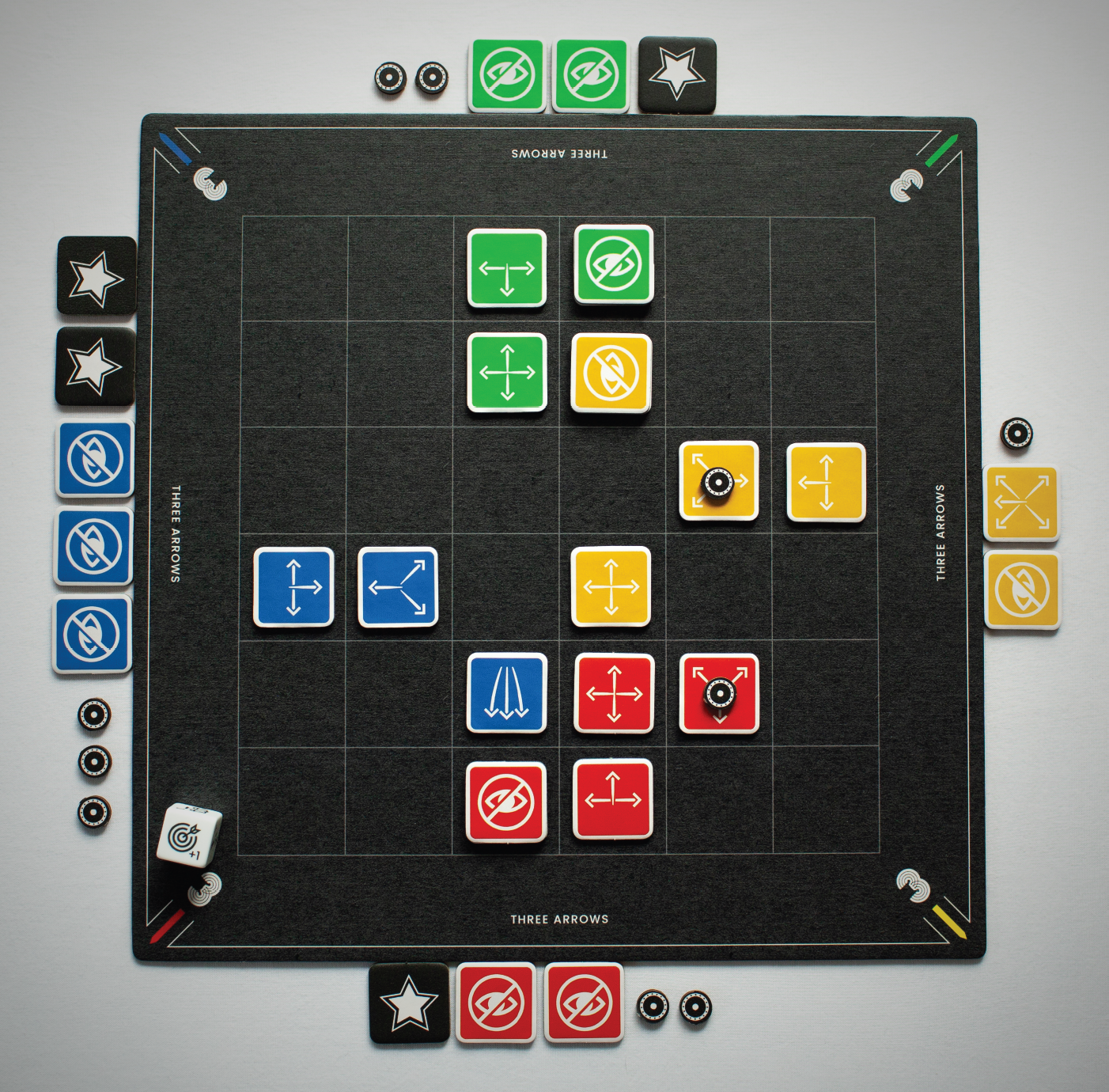
Each player starts with 17 arrow pieces, 3 cover pieces, 3 shields and 1 bonus piece as shown:
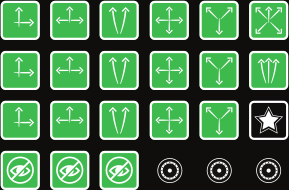
Players conceal their regular Arrow Pieces from their opponents by placing them behind screens. The 3 cover pieces, 3 shields and the Terminator piece are not concealed and are placed where they are visible to all players.

The starting player can be determined in any way you decide. Players then take turns in a clockwise direction around the board.
On their turn players must make one of the following three moves (described in detail later), if they are able.
1. Place a piece

2. Attack a piece

3. Remove an opponents shield

Players can place their very first piece in any of the outside squares except the four corner squares. Also, players cannot place in an outside row where another player has already placed their piece.
In this example, the blue player has already placed on the outer right row. The squares where the next player can place are highlighted:

On subsequent turns, a player can place pieces in any squares directly adjacent to an existing Arrow Piece, where this existing Arrow Piece has an arrow pointing to that square.
The squares where the red player can place their next piece are highlighted:
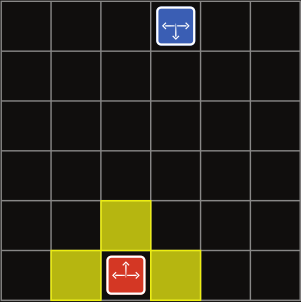
In this next example, the red player has 2 pieces on the board.
The squares where the red player can place their next piece are highlighted:
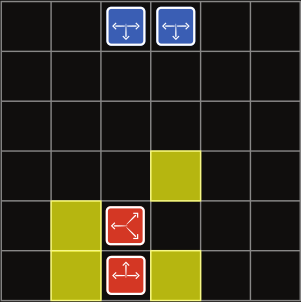
When a player has a piece directly adjacent to an opposing player’s piece, with an arrow from this piece pointing towards the opposing player’s piece, they may choose to attack the piece.
On their turn the player announces their piece they are attacking from and the opponent's piece they are attacking.
In the following example, the red player can attack the highlighted blue piece from their adjacent highlighted red piece.
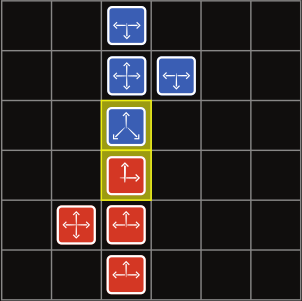
The attack row consists of a straight line of the attacking player's pieces with no gaps and no opposing pieces between them, leading up to and including the piece that the player is attacking from.
This row must be a continuous line of pieces and be aligned towards the piece the player is attacking.
In the following example the attacking red players attack row is highlighted.
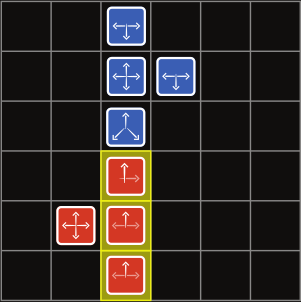
The defence row is the continuous straight line of the defending players' pieces, with no gaps and no opposing pieces between, aligned towards the attack row.
In the following example the defending blue players' defence row is highlighted, aligned towards the attacking red players adjacent L shaped piece.

When a player attacks on a diagonal from one of their Y-shaped pieces' diagonal arrows, the attack row is composed of the pieces aligned diagonally towards the piece they are attacking.
The defence row is composed of the defending player's pieces aligned diagonally in the opposite direction, forming a continuous line with no gaps and no opposing pieces between them, towards the attack row.
This example shows the diagonal attack and defence rows highlighted, and an arrow showing the direction of the attack from the leading red Y piece attacking the blue T piece:

The initial attack strength is determined by adding up the number of uncovered arrows in the attack row that point towards the defending player's piece.
In this example, the arrows in the highlighted attack row, that point towards the defending player’s piece, are highlighted showing an initial attack strength of 4 arrows:
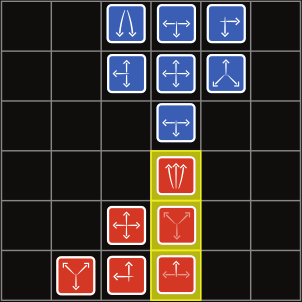

The attacking player then rolls the dice and the result from the dice is applied to the initial attack strength to give the final attack strength.
The defence strength is determined by adding up the number of uncovered arrows in the defence row, that point towards the attacking player's piece.
In this example, the arrows in the highlighted defence row, that point towards the attacking player’s piece are highlighted and equal 3:

If the final attack strength is greater than the defence strength the attacker captures the defending player's piece.
If the defence strength is greater than the final attack strength the defender captures the attacking player’s piece.
If the final attack strength and the defence strength are equal, the attack is a draw.

* Captured pieces are placed in front of the capturing players privacy screen so they are visible to other players.
If the attacking player wins the attack, they may choose to move their piece into the square that held the captured piece.
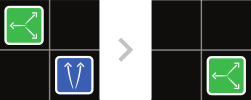
They may also rotate their piece to face in any direction they wish in this new location.

If they choose not to move the piece, the piece remains where it is and it may not be rotated. * Defending players cannot move or rotate their piece if they win
Players can choose to cover a piece when they first place the piece on the board. Each player begins the game with 3 cover pieces. When a piece is covered, the opposing players will not know which piece is placed on square, or which direction it faces.
In this example, the blue player has placed a covered piece on the board. The red player can still attack the covered piece, but will not know the defence strength of the covered piece.
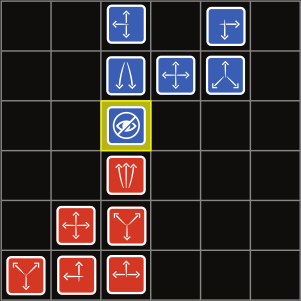
A player may optionally uncover one or more of their covered pieces at any time on their turn. This does not use a turn or an action. The removed cover is discarded and cannot be reused in the game.
If an attacking player wishes to include the arrows from covered pieces in their attack row, they must remove the cover from these pieces BEFORE they announce their intention to attack.
A defending player is given the option to uncover any covered pieces in their defence row BEFORE the dice is rolled.
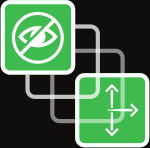
* If a piece is left covered the arrows underneath are not counted in the defence or attack strength. A player cannot place new arrow pieces from a covered piece.
A piece can have a shield placed on top of it when it is first placed on the board. When a piece is shielded, opposing players must remove the shield before the piece can be attacked and captured.
A shield can only be removed by an opposing player if they have an uncovered piece directly adjacent to the shielded piece, with an arrow pointing towards it.
Removing a shield uses a turn, so placing a shield on the piece helps protect it. When a shield is removed, it is discarded and cannot be reused.
In the example shown, the blue player has a shield on one of their pieces. The red player would need to use a turn to remove this shield before they can attempt to capture the shielded piece.
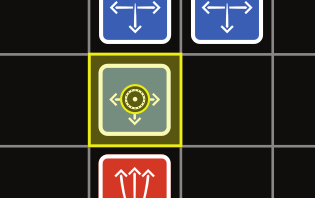
Note that if a player attacks using a shielded piece, and loses the attack, their shield is also lost. The shield is discarded and not captured by the defending player.

Each player starts the game with one bonus piece.
Attacking players receive a bonus piece each time they:
Roll the broken arrow (-1) on the dice as part of the attack AND they fail to capture the piece.
In this example the attacking red player receives a bonus piece after attacking, rolling -1 on the dice, and failing to capture the piece.

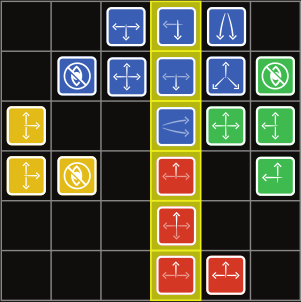
* Beginners can skip this rule: skip this >
Defending players receive a bonus piece in the following situation:
They lose their piece in an attack that was initially equal/drawn (before the dice was rolled) because the attacker subsequently rolls +1 on the dice. In other words, the attacker only won due to the luck of the dice.
In this example the defending blue player receives a bonus piece after the attacking red player wins the initially equal attack by only one arrow, after rolling +1 on the dice.

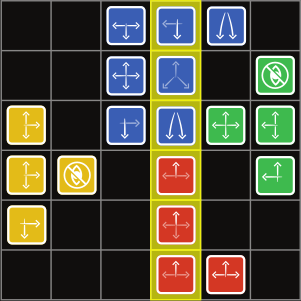

Once a player has collected two bonus pieces, they can use them as the very first action of their turn to get an extra turn (+1 turn) - it must be the first action they take at the start of their turn.
Bonus pieces can be saved up for increasingly more bonus turns. If a player collects three bonus pieces they can use them for two extra turns (+2 turns). Four for +3 turns, five for +4 turns and so on.
When bonus pieces are used they are discarded and returned to the pile.

* This rule will likely not apply to very short games (e.g. first to capture 3 pieces), as you will most likely not reach the point the terminator can be played. skip this >
The first Terminator piece can be placed by any player who has used up all their other arrow pieces.
Once the first player has placed their terminator piece, the only arrow piece the other players can place is their own terminator piece - even if they have other arrow pieces remaining.
After a Terminator piece has been placed on the board, pieces can no longer be moved after a successful attack - they remain where they were before a successful attack.
A Terminator piece cannot be covered, but can be shielded
* Players can still perform other actions, like attacking or removing a shield, before placing their Terminator piece.
* If you're playing first to capture a set number of pieces (e.g. first to 3), the game ends as soon as a player captures the set number of pieces - otherwise read on below:
The game ends when all players have played out all possible moves.
The winner is the player who has captured the most arrow pieces from other players, and still has pieces remaining on the board.
A player is eliminated from the game if they have no pieces remaining on the Board.
If players have captured an equal number of arrow pieces, the player with the most unused bonus pieces wins the game.
If players have captured an equal number of arrow pieces AND have an equal number bonus pieces remaining, they draw.
* This is the best option for beginners
If you’re after a faster Three Arrows experience you can play a fast game by playing that the first player to capture a set number of pieces is the winner (e.g. first to 3, first to 6 etc).
This won’t give you the full nuanced and balanced Three Arrows experience but is a great way to start out or play a fast game.
Three Arrows can be played in ‘tactical mode’ by excluding the dice and covers from the game. In this mode any drawn attacks are ignored and pieces can only be captured by having a majority of arrows in the row.
The four player game can be played in two teams. All the normal rules apply and the team with the most combined captured pieces at the end of the game wins.
See some of the advanced modes available on the free web app including 'start anywhere' and different board sizes.